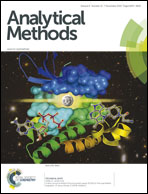In situ reduction and functionalization of graphene oxide with l-cysteine for simultaneous electrochemical determination of cadmium(ii), lead(ii), copper(ii), and mercury(ii) ions†
Abstract
One pot reduction and functionalization of graphene oxide (GO) with L-cysteine (L-cys-rGO) at the edges and basal planes of the carbon layers are presented. The L-cys-rGO was characterized by X-ray diffraction studies (XRD), X-ray photoelectron spectroscopy (XPS), attenuated infrared spectroscopy (ATIR), and Raman spectroscopy. The surface morphology was studied by scanning electron microscopy (SEM) and transmittance electron microscopy (TEM). The L-cys-rGO was further utilized for the simultaneous electrochemical quantification of environmentally harmful metal ions such as, Cd2+, Pb2+, Cu2+ and Hg2+. Detection limits obtained for these metal ions were 0.366, 0.416, 0.261 and 1.113 μg L−1 respectively. The linear range obtained for Cd2+, Cu2+ and Hg2+ was 0.4 to 2.0 μM and for Pb2+ was 0.4 to 1.2 μM. The detection limits were found to be less than the World Health Organization (WHO) limits. The developed protocol was applied for the determination of the above metal ions in various environmental samples and the results obtained were validated by atomic absorption spectroscopy (AAS).


 Please wait while we load your content...
Please wait while we load your content...